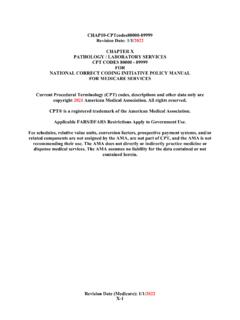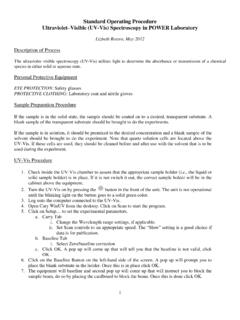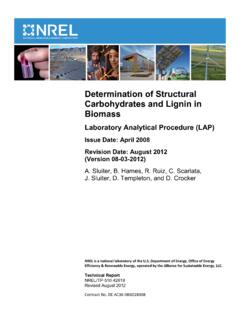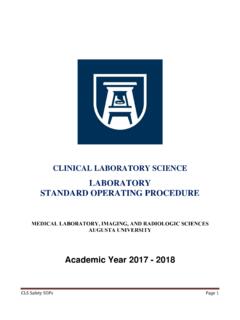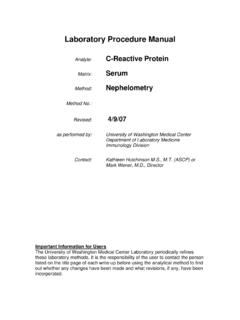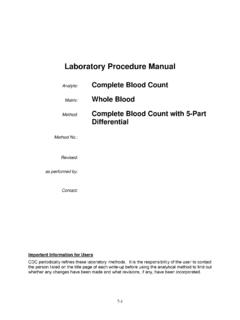Transcription of Lab Procedures – Preparing Laboratory Reports
1 NAME:_____ PERIOD:_____ DATE:_____. THESE WILL BE REFERRED TO AS YOUR PINK PAPERS KEEP THESE PAPERS UNTIL JUNE, 2008. Lab Procedures Preparing Laboratory Reports A Laboratory report is a written record of an investigation. Such a report is an integral part of a Laboratory experiment. Here are the names and brief descriptions of the sections of a Laboratory report. Except for skill labs, lab Reports will be required for one lab per cycle. During each cycle, your teacher will tell you which lab will need a written report. Heading The upper right hand corner of your lab report must include only the following: Your name followed by the letter P and your period #.
2 Both on the same line. No punctuation. The Lab #. If your lab report is two sheets of paper, write Page 2 of 2 in the upper right hand corner of your second page underneath your name and lab #. Do not staple your pages together. If your lab report is three sheets of paper, label the second page Page 2 of 3 , etc. Do not label the first page Page 1 of 1 . Title This is the name of the Laboratory investigation you are doing. In an investigation from a Laboratory manual, the title will be the same as the title of the investigation. The title should be centered on the line right after the heading. You may underline the title if you desire (and/or bold if using a computer).
3 Purpose or Goal The purpose or goal is a brief statement of the goals to be achieved by conducting the experiment. This statement is always given at the beginning of the experiment. Other words for purpose include goal or objectives. Your Name P2. Lab# 01-X45. Melting of Ice PURPOSE. The purpose of this lab is to determine the melting point of water (ice). EQUIPMENT/MATERIALS. Graduated cylinder (25-mL), balance, copper sulfate PROCEDURE. In this experiment, I obtained a sample of ice. Using a balance, I found the mass of . DATA/OBSERVATIONS. See below for an example of a nice data table! Equipment/Materials This is a list of all the equipment and materials you needed to complete the investigation.
4 In investigations taken from a Laboratory manual, the materials are sometimes listed for you. Procedure (will not be required on most lab Reports ). The procedure is a step-by-step description of the activities that were done in order to gather the information needed to achieve the purpose of the experiment. Sometimes the procedure will already be carefully written out for you. All you need to do is to give a summary of the major steps of the procedure. Data/Observations Your data is another name for what you have observed. This section is a running account of what takes place during the course of an investigation. All of your observations, qualitative and quantitative, must be recorded in this section.
5 Entries in the final sections of the lab report will be based on the information recorded here. Thus, it is vital that this information be complete, well-organized, accurate, and properly labeled. It is often recorded in the form of tables, graphs, and diagrams. Any data or calculation tables must be neatly drawn with a ruler or straight edge. A margin of at least on the left and right sides. Your data table will have at least two columns: - A description of your data/observation - The actual observation or value Here is an example of a good data table: Lines are drawn on the top, bottom and sides of the table. A single line is drawn under the column headings.
6 NO lines are drawn between the entries in the table. This table was done with Word97 using a table. Data/Observation Trial #1 Trial #2. Mass of Weighing Paper g g Mass of Weighing Paper + NaCl g g Volume of Liquid before reaction ml ml Volume of liquid after reaction ml Color of liquid before reaction clear Color of liquid after reaction clear Mass of NaCl g Observations and/or comments The second trial was interrupted by a fire drill. Lab Partner Debbie Fisher Lab Date 09-25-2007. Lab Station #12. Lab Balance #5. Lab Thermometer #2. As shown in the example above, the last section of your data table must include the following: The full name of your partner(s).
7 If working alone, write No partner . Lab Date. The date you did the experiment in class, not when you did the lab report. If the experiment was done over a period of two or three days, include all dates. You will not use a balance or thermometer for every lab. If not used, these items do not need to be included in the lab. You may include them and put dashes or write n/a . Any other information as required by your teacher. 2. Calculations In many cases, the "raw" data collected during the course of an experiment must be "processed" before valid conclusions can be reached. Processing data can include making mathematical calculations.
8 The results of these calculations then are used as a basis on which to draw conclusions. In some experiments, the raw data are all that is needed for the purpose of drawing conclusions. In such cases, the calculations section is omitted from the Laboratory report. You may be asked to put calculations in a separate Calculation Table. In many cases, you will be told to include the calculations as part of the Data Table. Note that in the above table Mass of NaCl is a calculation, not data. Sample Calculations You will usually be asked to show work for some of the calculations in your lab report. For example: You are asked to calculate the mass of NaCl used in your experiment by using the formula: Mass of NaCl = Mass of Weighing paper with NaCl Mass of Weighing paper You may have data for two or even three trials as part of your data or calculation table.
9 However, you would only show the work for calculating the mass for trial #1. When you show your work, you always write three steps. First, you write the formula used. Second, you fill in the formula with your numbers. Finally, you write your answer. Remember to include units following all numbers in your calculations. Here is an example of a sample calculation using the three step method: Mass of NaCl = Mass of Weighing paper w/ NaCl Mass of Weighing paper Mass of NaCl = g g Mass of NaCl = g Conclusions and Questions This can be the most difficult part of the investigation. It explains what you have learned. If asked, you should explain any errors you made in the investigation.
10 Keep in mind that not all of your work will be perfect. This is normal. You just need to explain why things did not work out the way that you thought they would. In many investigations, there will be questions to guide you in analyzing your data. You should use these questions as a basis for your conclusions. Some General Procedures for Lab Reports If handwritten, use dark blue or black ink on white lined paper. No pencils or markers. Use white lined paper. You may use both sides of the paper. If using a computer, use 8 x 11 standard plain white paper 20 or 24 pound. Nothing fancy! Maximum number of folds for your report: one Edgies must be removed.
